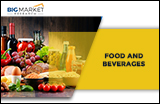
Global Carbonated Beverages Market
- MAR2978994
- 201 Pages
- August 2018
- Food and Beverages
Market Dynamics
The modern lifestyle and habits of people play a major in the consumption of the carbonated drink and drive the market. The positioning of the product also play a major role in making the customer perceive the product to be cool. The fast food chains play a significant role in accelerating the market demand for carbonated drink. The growing health consciousness among people are a deterrent to market growth, however this is minimal. Companies are diversifying the product for health conscious segment.
Market Segmentation
The global carbonated beverages market is segmented product type as standard, diet and fruit flavoured. The diet products are in increasing demand due to lesser sugar content. By flavours, they are segmented in to cola, orange and lemon. These are the basic flavours which contribute to major market share, while companies have introduced more natural flavours. The carbonated drinks is segmented by sales channel as products sold in hypermarket, supermarket and retailers.
Regional/Geographic Analysis
The global carbonated beverages market is dominated by the market share in Europe. Matured markets like North America where health concern is high has seen reduction in the demand. Developing nations and regions in Asia Pacific such as China, India, South Korea, South East Asia and Japan is expected to have high market growth in the carbonated beverages market owing to change in lifestyle combined with increased per capita income.
Key Players
The key players in the carbonated beverages market are PepsiCo, Coca-Cola, Britvic PLC, Cott Corporation, Parle Agro and Postobon.
Report Contents:
> Market segments
> Market Drivers, Restraints and Opportunities
> Market Size & Forecast 2016 to 2022
> Supply & Demand Value Chain
> Market - Current Trends
> Competition & Major Companies
> Technology and R&D Status
> Porters Five Force Analysis
> Strategic and Critical Success Factor Analysis of Key Players
Regional Analysis:
> North America
>> US and Canada
> Latin America
>> Mexico, Brazil, Argentina and Rest of Latin America
> Western Europe
>> EU5 (Germany, France, Italy, Spain, U.K.)
>> Nordic Countries (Denmark, Finland, Norway, and Sweden)
>> Benelux (Belgium, The Netherlands, and Luxembourg)
>> Rest of Western Europe
> Eastern Europe
>> Russia
>> Poland
>> Rest of Eastern Europe
> Asia Pacific
>> China
>> India
>> Japan
>> Australia and New Zealand
>> Rest of Asia Pacific
> Middle East and Africa
>> GCC countries (Saudi Arabia, Oman, Qatar, Bahrain, UAE and Kuwait)
>> South Africa
>> North Africa
>> Rest of Middle East and Africa
This report is an elaborate aggregation of primary inputs from industry experts and participants across the supply chain. It provides details on market segmentation which is derived from several product mapping exercises, macroeconomic parameters and other qualitative and quantitative insights. The impact of all such factors is delivered across multiple market segments and geographies.
Report Highlights:
> Detailed Historical Overview (Market Origins, Product Launch Timeline, etc.)
> Consumer and Pricing Analysis
> Market dynamics of the industry
> Market Segmentation
> Estimated Market Sizing in terms of volume and value
> Recent trends in Market and impact
> Research Status and Technology Overview
> Extensive Industry Structure Coverage
 
Similar Reports
Driven by improving living standards of people and a fast-growing macro-economy, China has remained the largest beer-consuming country worldwide for the 12th consecutive year since 2003, and the largest beer-producing nation globally in the past years. This report focuses on systematic evaluation and analysis of Internal Risks (arising within the industry development itself) and External Risks (ar...
- Publish Date: November 26, 2014
- $800
Summary Based on products type, the report describes major products type share of regional market. Products mentioned as follows: By Type Microparticulated Protein Modified Whey Protein Concentrate Others Based on region, the report describes major regions market by vendor, products and application. Regions mentioned as follows: North America Europe Asia RoW Based on application, the repor...
- Publish Date: March 1, 2017
- $840
Summary The global Oat Protein market is estimated to reach 1.4 K MT in 2017. The objective of report is to define, segment, and project the market on the basis of type, application, and region, and to describe the content about the factors influencing market dynamics, policy, economic, technology and market entry etc. Based on products type, the report describes major products type share of regio...
- Publish Date: April 15, 2017
- $840